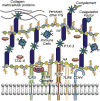Hyaluronan interactions with innate immunity in lung biology
- PMID: 29410190
- PMCID: PMC6072627
- DOI: 10.1016/j.matbio.2018.01.027
Hyaluronan interactions with innate immunity in lung biology
Abstract
Lung disease is a leading cause of morbidity and mortality worldwide. Innate immune responses in the lung play a central role in the pathogenesis of lung disease and the maintenance of lung health, and thus it is crucial to understand factors that regulate them. Hyaluronan is ubiquitous in the lung, and its expression is increased following lung injury and in disease states. Furthermore, hyaladherins like inter-α-inhibitor, tumor necrosis factor-stimulated gene 6, pentraxin 3 and versican are also induced and help form a dynamic hyaluronan matrix in injured lung. This review synthesizes present knowledge about the interactions of hyaluronan and its associated hyaladherins with the lung immune system, and the implications of these interactions for lung biology and disease.
Copyright © 2017. Published by Elsevier B.V.
Figures


References
-
- Mannino DM, et al. Surveillance for asthma--United States, 1980–1999. MMWR Surveill Summ. 2002;51(1):1–13. - PubMed
-
- Kochanek KD, et al. Deaths: final data for 2009. Natl Vital Stat Rep. 2011;60(3):1–116. - PubMed
-
- Ford ES, et al. Total and state-specific medical and absenteeism costs of COPD among adults aged >/= 18 years in the United States for 2010 and projections through 2020. Chest. 2015;147(1):31–45. - PubMed
-
- Mannino DM, Braman S. The epidemiology and economics of chronic obstructive pulmonary disease. Proc Am Thorac Soc. 2007;4(7):502–6. - PubMed
Publication types
MeSH terms
Substances
Grants and funding
LinkOut - more resources
Full Text Sources
Other Literature Sources

